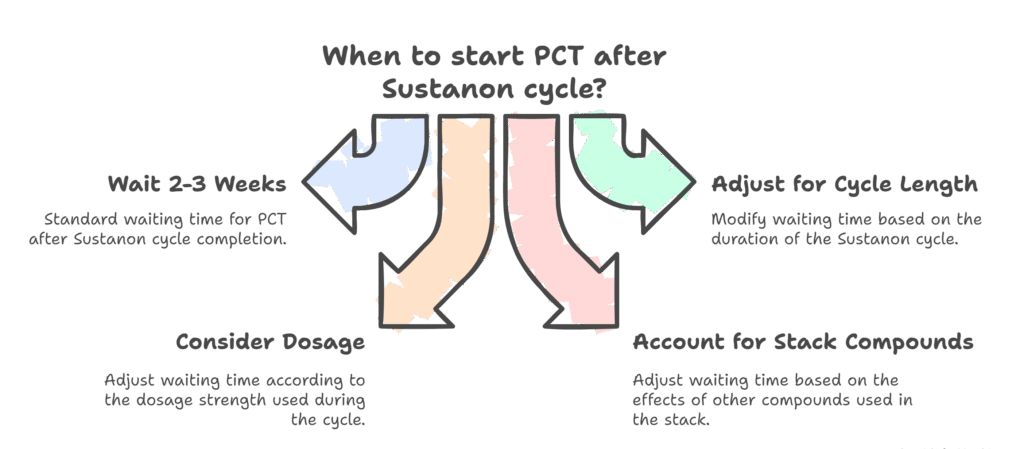Sustanon is one of the most popular anabolic steroid blends that is applicable in bodybuilding cycles. As post-cycle therapy (PCT) is important for any steroid cycle, it is important to know what the PCT for Sustanon looks like. This will be a guide on that.
An AAS cycle without PCT has huge risks, such as side effects, some of which, after a certain level, can be irreversible. Therefore, to achieve the best results for the cycle, it is essential to implement effective PCT practices. And this blog will look into these practices.
Understanding Sustanon and Its Impact on the Body
Sustanon is a mix of four testosterone compounds, namely: Testosterone Propionate, Testosterone Phenylpropionate, Testosterone Isocaproate, and Testosterone Decanoate. These four active esters support your body by increasing protein synthesis and nitrogen retention to support muscle gain.
Sustanon works by creating a consistent release of testosterone in the bloodstream. And this helps maintain stable testosterone levels in your body for a significant period. And during a sustanon cycle, the benefits include an increase in strength, growth in size, and faster recovery.
However, without responsible usage, the dose increases can overload your body. And this can lead to side effects, including suppression of natural testosterone production. And over time, this can lead to mood swings, low libido, and even gynaecomastia. And this is exactly why PCT after Sustanon is necessary.
Why PCT Is Essential After Sustanon
A basic outline of the potential side effects of continued usage of Sustanon has been provided in the last section, and that has been stated as the reason for PCT being essential after Sustanon. So, what exactly makes PCT for Sustanon crucial? Firstly, as your body’s natural testosterone production is suppressed by a continued cycle, PCT can help gradually restore that natural testosterone production in your body.
Sustanon is also an AAS with high aromatizing effects. This means that it will get converted into oestrogen within your body. Therefore, PCT will be required for minimizing the oestrogen rebound condition and managing its side effects.
PCT can help manage the potential Sustanon challenges, such as water retention, fat gain, mood swings, or even gynecomastia. Essentially, it inhibits the estrogenic risks while also preserving muscle mass throughout the training process.
Also, without PCT, a potent AAS such as Sustanon can harm your long-term hormonal health. And this is the reason that you absolutely cannot skip out on PCT after a Sustanon cycle.
Why Timing PCT After Sustanon is Relevant
The timing for starting your PCT is critical to the ideal impacts of the therapy being most pronounced on your health. And the half-life of each of the testosterone esters significantly impacts the start time for the PCT cycle.
So, when to start PCT after Sustanon? The typical waiting time after a cycle is completed is 2 to 3 weeks for starting the PCT.
There are other factors as well that will affect how long after Sustanon to start PCT. These factors can include:
- Cycle Length: How long you should wait will differ from user to user, depending on the cycle length.
- Dosage: Your dosage strength will impact how long you should wait to start PCT.
- Stack Compounds: Depending on your stack and how it affects your body’s hormonal balance, you should consider your wait time to start PCT.

Common PCT Protocols for Sustanon
When running an aromatising AAS such as Sustanon, your oestrogen levels can rise significantly, often over the manageable levels. In such situations, the common PCT protocols will generally involve oestrogen blockers such as SERMS, Aromatase Inhibitors, and hCG.
So, when considering PCT after Sustanon, here are some of the common PCT protocols to go for:
#1. SERMs (Selective Estrogen Receptor Modulators)
SERMs are often the most preferred PCT choice after any AAS cycle. But how do they work? This knowledge will be essential in understanding why they could be crucial after a Sustanon cycle.
SERMs do not actually reduce oestrogen levels in the body. However, what they do is bind to the oestrogen receptors in particular tissues. And in this way, they block the oestrogen from exerting its effects. That makes SERMs useful in preventing or reversing gynecomastia, while also not leading to a crash of the natural oestrogen levels.
There are two popular examples of SERMs that are often recommended in Sustanon cycles. These include:
- Clomid (Clomiphene Citrate): Clomid helps boost LH (Luteinizing Hormone) and FSH (Follicle-Stimulating Hormone).
- Nolvadex (Tamoxifen): Nolvadex works by blocking oestrogen at receptor sites.
Here is a chart exploring the mechanistic comparison between Clomid and Nolvadex:
| Mechanisms | Clomid | Nolvadex |
| Oestrogen receptor binding | Mixed activity owing to isomer composition | Selective in the breast and hypothalamus |
| LH/FSH | High | Low to Moderate |
| Side effects | Frequent (usually related to mood swings) | Mild; usually well tolerated |
| Common uses | Strong post-cycle hormonal kickstart | Testosterone support; gynecomastia prevention |
Table 1: Clomid vs. Nolvadex Mechanisms
Also, for an effective understanding of the dosage practices, here are examples of typical Clomid and Nolvadex dosages:
| Week | Clomid Daily Dose | Nolvadex Daily Dose |
| 1-2 | 50 mg/day | 40 mg/day |
| 3-4 | 25 mg/day | 20 mg/day |
Table 2: Typical Recommended Dosage
Please note that these dosages mentioned are only examples based on typical recommended doses. So, do not consider these as practical choices without the recommendations of a physician.
#2. Aromatase Inhibitors (AIs)
Unlike the SERMs, AIs do not just block the effects of oestrogen on your body; they focus on stopping it from being created. AIs inhibit the aromatase enzyme, which is responsible for the conversion of testosterone into estradiol (the most abundant and potent form of oestrogen).
Thus, AIs essentially block the oestrogen amount in your body from exceeding the acceptable amounts, keeping the areas where oestrogen exerts its influence safe. Thus, when considering steroids of high estrogenic impact, AIs can be extremely effective.
However, when considering taking AIs, you need to listen to a physician’s recommendations. This is because AIs should only be taken when necessary. And it is not considered among the general requirements for PCT for Sustanon.
#3 hCG (Human Chorionic Gonadotropin)
hCG is a glycoprotein hormone that is produced by trophoblastic cells of the placenta shortly after fertilisation. These cells support egg fertilisation and nourish the developing embryo.
And it is used in bodybuilding cycles for a few purposes, which include:
- As a bridge between steroid cycles during PCT.
- To taper off the effects of anabolic steroids.
- To restore the natural testosterone production after suppression due to AASs.
And like the previous examples, it is important to consider how much hCG to take as excessive amounts can lead to side effects, such as persistent headaches, restlessness, or even irritability.
Sample PCT Schedule After Sustanon
So, what can be represented as a sample PCT schedule after a Sustanon cycle? Here is a chart that shows the ideal combination of Clomid and Nolvadex on a typical SERM-based PCT schedule:
| Week | Clomid (Daily dosage) | Nolvadex (per day) | Notes |
| 1 | 50 mg | 40 mg | Higher dosage |
| 2 | 50 mg | 40 mg | Higher dosage (+ AIs if needed) |
| 3 | 25 mg | 20 mg | Tapered dosage |
| 4 | 25 mg | 20 mg | Tapered dosage |
Table 3: Sample PCT Schedule for Sustanon
This chart shows a sample beginner’s Sustanon PCT cycle. However, this amount is not set in stone. The amount you need to take will depend on your physician’s recommendations, and the dosage will be heavily dependent on the controlled Sustanon dosage for women.
Mistakes to Avoid With PCT After Sustanon
So, if you have chosen to consider a Sustanon dosage, and you need to follow through with a PCT cycle, here are some of the common mistakes that you would need to avoid:
- Starting with the PCT too early after the Sustanon cycle or waiting too long post-cycle.
- Overusing multiple PCT drugs unnecessarily, especially when it comes to considering AIs to hCG.
- Ignoring bloodwork. Periodic bloodwork is essential for long-term benefits.
- Resuming steroid use before full recovery.
Wrapping Up
Sustanon is a potent AAS and therefore it suppresses Testosterone. And that is why PCT is critical for recovery. And always remember that Proper timing, protocol, and support strategies are necessary to restore balance. And the safest and most effective measure is combining a tailored approach to PCT and regular bloodwork.
Starting PCT After a Sustanon Cycle? Here’s What to Do!
A tailored approach to the PCT cycle is essential. So, you need to ensure that your dosages are controlled and that you consult a physician before starting the therapy protocol. Plus, make sure to consistently monitor blood composition, as it can be essential for recovery.
Frequently Asked Questions
Yes. Sustanon can be combined with bulking AASs in a cycle to increase muscle growth and strength. Stack options can often include Dianabol, Deca Durabolin, and so on.
Sustanon 250 is a potent AAS. This implies that it can lead to harmful side effects after a particularly long cycle. Some of these side effects can also be irreversible. Therefore, even for one cycle, it is recommended not to miss out on PCT.
No. SERMs are generally considered PCT. Therefore, there is a waiting period to consider before taking them after a cycle. Thus, it is not recommended to take SERMs alongside your Sustanon cycle.
As PCT, both have an important effect on the impact of oestrogen aromatisation on your body. Therefore, both can be equally important, and usually recommended to be considered together.




